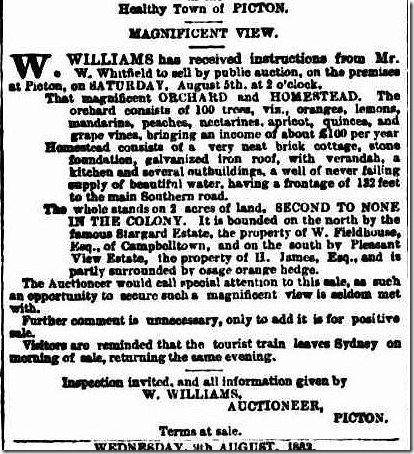Posted originally on January 30, 2015 by Neil
This series of posts is the most comprehensive I have done on family history. I am doing them backwards here so that in due course they will appear sequentially.
I want to follow up yesterday’s post which, you may recall, detailed the sad fate of William Whitfield (1812-1897) and the impact of the Depression of the 1890s on his son William Joseph John Whitfield (1836-1925), whose son in turn (Thomas Daniel Sweeney Whitfield 1866-1948) was my grandfather at whose knee I have sat. Just think: when William was born Napoleon was off to Russia, and William Joseph John lived through World War 1.
I was really moved by the extra detail about William’s death in Rushcutter’s Bay. Afterwards I wondered what happened to his wife, Caroline Philadelphia West. I also wondered just when William had returned to the inner Sydney he had left in the1840s. The second I don’t know yet, but the first is a sad story again.

William Whitfield and his wife Caroline Philadelphia

1881: leaving a husband and 13 children
The following year William sold up:

Location, location, location:
Once occupied by the Gundungura and Tharawal Aborigines, the first Europeans to investigate the area around Picton were the party of ex-convict John Wilson who passed through in 1798. They had been sent by Governor Hunter to accumulate data about the southlands to discourage convicts who were escaping and heading south in the belief that China was only 150 miles away.There was already a very small European presence to the north around present-day Camden, consisting of stockmen sent to tend the cattle on the Cowpastures, although all other settlement of that area had been forbidden in order to ensure the development of the herd (see entry on Camden for further information on the Cowpastures).
By 1819 Governor Macquarie had authorised the construction of a road from Picton through to the Goulburn Plains. The first land grant in the area was ‘Stargard’, a gift to Christian Carl Ludwig Rumker, Governor Brisbane’s astronomer, in honour of his rediscovery of Encke’s Comet. Nearby Major Henry Antill established a 2000-acre property in 1822 which he first named ‘Wilton’, subsequently renaming it ‘Jarvisfield’ after Jane Jarvis, the wife of his friend, Governor Macquarie. The station stretched from Stonequarry Creek to Razorback. The family home still stands although now it is used as the clubhouse for the Antill Park Golf Club….


Stargard Estate today
Moving now to the son, William Joseph John: I was struck by the details of that sad auction announcement. It really must have been quite a big concern, that Blue Gum Mill. One of the items listed is a 14hp Rushton Proctor Portable Engine. Imagine that!

Casting forward to 1903 I note this:

That is one of my father’s younger aunts, the daughter of William Joseph John. They settled in Wellington NSW where in the late 60s and early 70s I stayed in their house with their daughter Dorothy. They were deceased by then. The house however had quite a few treasures, including a Whitfield family Bible that may have been old William’s. The groom’s father long lived in Appin NSW, part of the district including Picton – just the other side of the escarpment I see from my window. There is a famous tale about Appin: Massacre at Appin in 1816.
When Europeans took up land grants, they cleared and fenced the land, irrecoverably changing the patterns of hunting and gathering that had been followed by the Dharawal people for tens of thousands of years.
Some European settlers formed a close rapport with Aborigines. Charles Throsby of Glenfield was accompanied by Dharawal men when he explored the southern highlands area. Throsby was a persistent critic of European treatment of the Aborigines. Hamilton Hume who, in 1814 with his brother John, made the first of a number of long exploratory trips southwards, did so in company with a young Aboriginal friend named Doual.
Whereas the “mountain natives” (probably Gandangara) had a reputation of being hostile in defence of their people and their land, the Dharawal were peaceful and had no history of aggression. Unfortunately few settlers could distinguish between the two groups.
In 1814, Macquarie issued an order in the Sydney Gazette, admonishing settlers in the Appin and Cowpastures area. “Any person who may be found to have treated them [natives] with inhumanity or cruelty, will be punished?.” This followed an atrocity when an Aboriginal woman and her children were murdered at Appin.
Two years later, in the drought of 1816, the Gandangara came again from the mountains in search of food. Europeans were killed and about 40 farmers armed themselves with muskets and pitchforks….
That becomes a very sad story. It is commemorated annually theses days: Annual Appin Massacre Memorial Ceremony.
On 17 April 1816, there was a massacre of Dharawal people near Appin. For over a decade now, the Winga Myamly (sit down and talk – Wiradjuri language) Reconciliation Group, which works towards Reconciliation by raising awareness of issues and promoting a partnership to bring about change for Indigenous people, has organised this Memorial Ceremony held on the Sunday afternoon closest to 17 April….
Just a reminder of the background behind the stories I have been telling and the places concerned.



